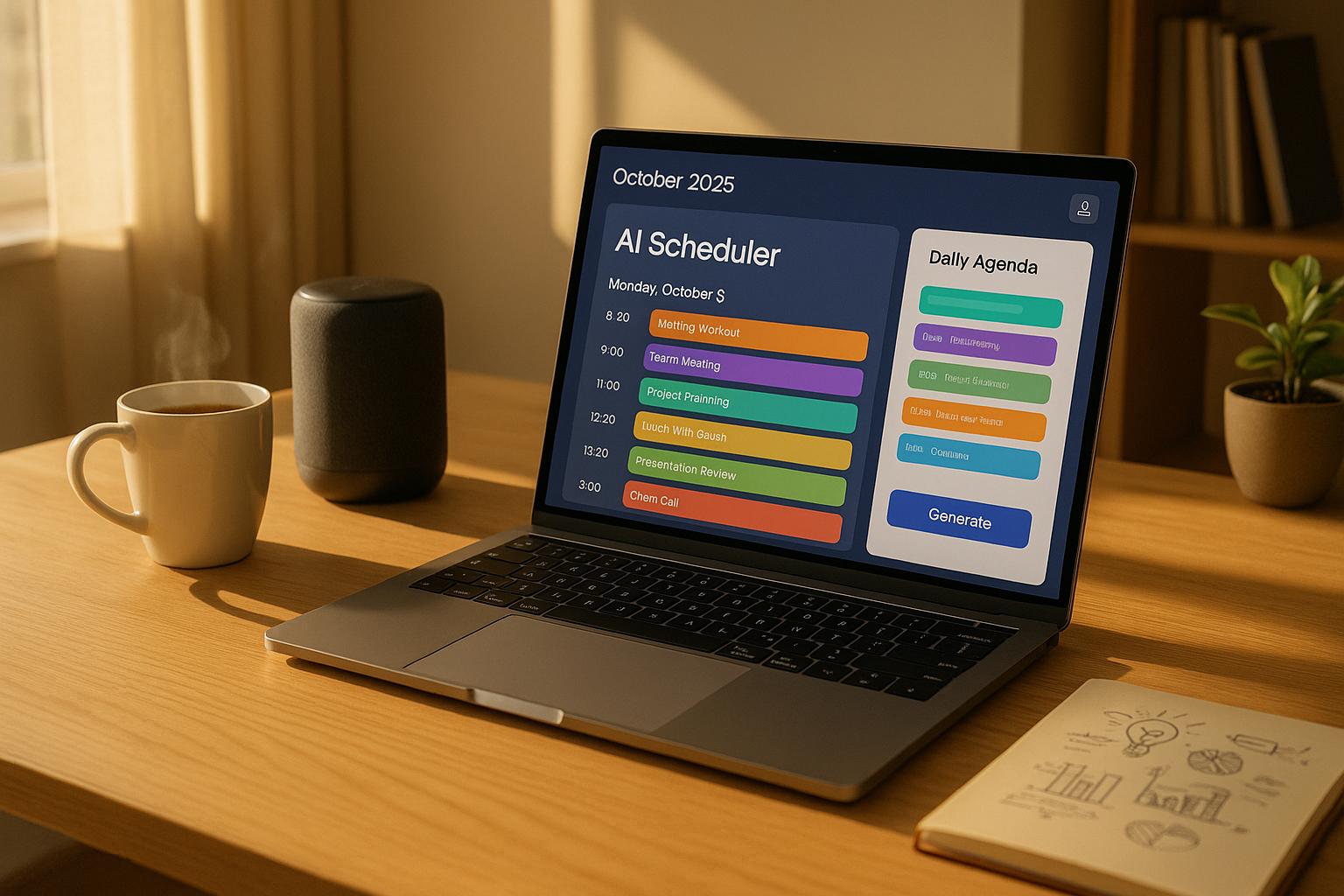By 2025, free AI tools have transformed education, making advanced technology accessible to students at no cost. Whether you're tackling essays, managing research, or preparing for exams, these tools simplify academic tasks, save time, and improve productivity. Here's a quick look at the top free AI tools available this month:
- AI Apps Directory: A hub of 1,000+ student-focused tools, from writing aids to research assistants.
- Google Gemini for Education: Simplifies research, writing, and problem-solving with a secure, institution-backed platform.
- NotebookLM: Organizes notes and materials, summarizes content, and creates personalized study aids.
- Quillbot: Enhances writing with paraphrasing, grammar checking, and citation tools.
- Otter AI: Transcribes lectures and meetings in real time, offering summaries and key insights.
- ChatPDF: Turns PDFs into interactive Q&A sessions for quick content analysis.
These tools are free to use, with optional premium upgrades for additional features. They cater to various academic needs, helping students work smarter without breaking the bank. Explore these options to streamline your studies and achieve better results.
The 8 Best AI-Powered Studying Apps - Free & Powerful 💡
1. AI Apps Directory
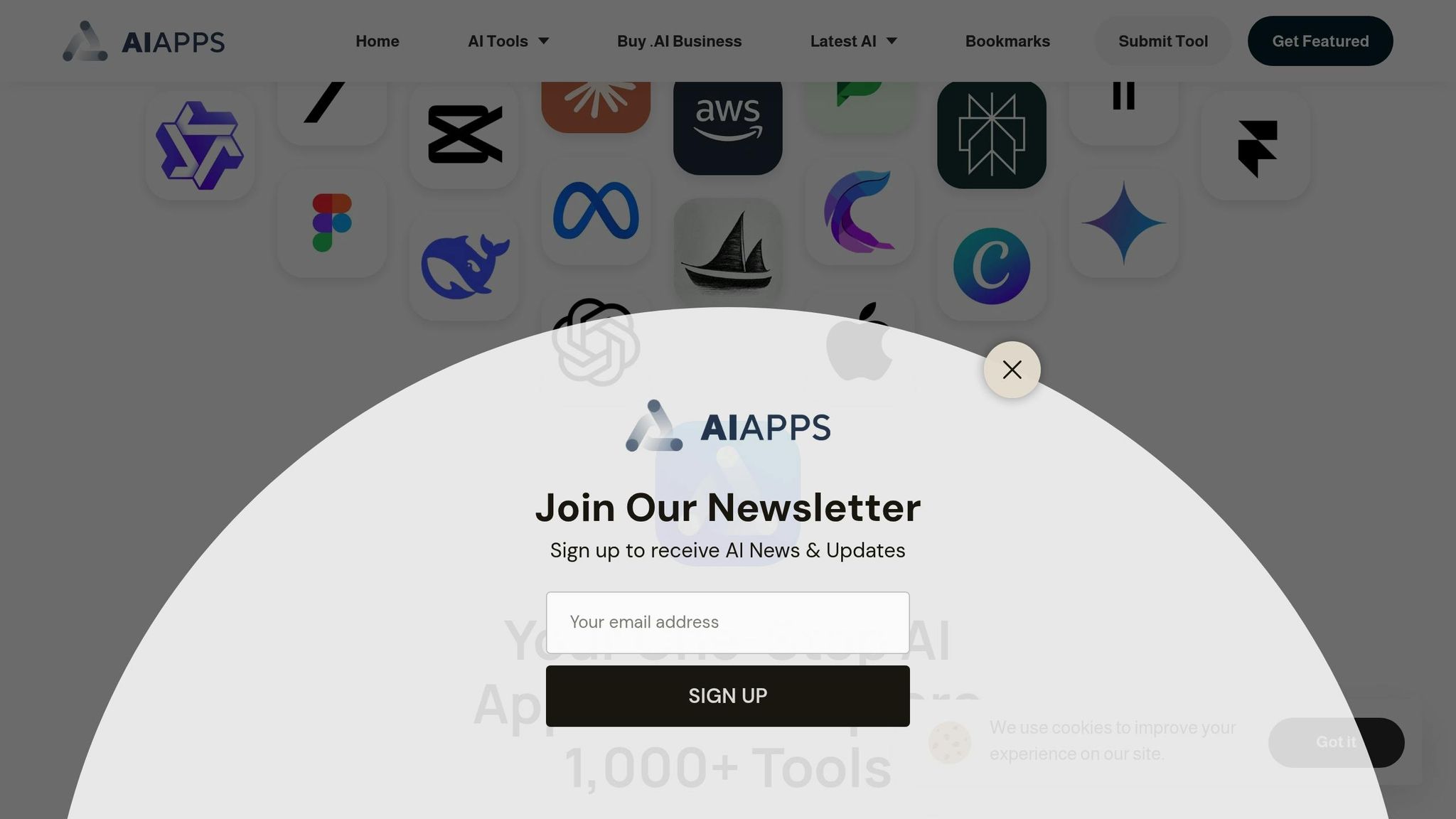
The AI Apps Directory is a treasure trove of over 1,000 AI tools designed specifically with students in mind. With its expansive collection, it caters to a wide range of academic needs, making it a go-to resource for tech-savvy learners.
Key Features Relevant to Students
The directory offers advanced filters that help students quickly find tools tailored to their specific academic goals. Whether you’re searching for AI writing assistants, research aids, or tools to streamline studying, the platform’s intuitive categorization ensures you’ll locate what you need with ease. Plus, a thorough multi-step verification process ensures only reliable, high-quality tools make the cut.
Practical Applications for Academic Tasks
This directory connects students with tools that can tackle a variety of academic challenges. For example:
- AI Art Generators unleash creativity for visual projects.
- AI Text Generators refine and elevate writing tasks.
- Research and data analysis tools simplify complex studies.
- AI Video Tools enhance multimedia projects for presentations or assignments.
The platform’s use-case-driven structure makes it easy to navigate, helping students find the right tools for research, content creation, collaboration, and more.
Free Plan Details and Usage Limits
The directory operates on a freemium model, allowing students to explore its extensive catalog at no cost. You can browse tool descriptions, explore categories, and access direct links without spending a dime. Revenue is generated through featured listings, keeping the basic access free for users.
Privacy and Accessibility Considerations
It’s important to note that some tools, like Google Gemini and NotebookLM, are only available to users aged 18 and older. Additionally, privacy standards vary across tools. Avoid sharing sensitive information when using these platforms, though certain tools - such as Google Gemini for Education and MagicSchool.ai - offer stronger privacy protections. Ready to dive deeper? The next section covers detailed insights into individual tools.
2. Google Gemini for Education
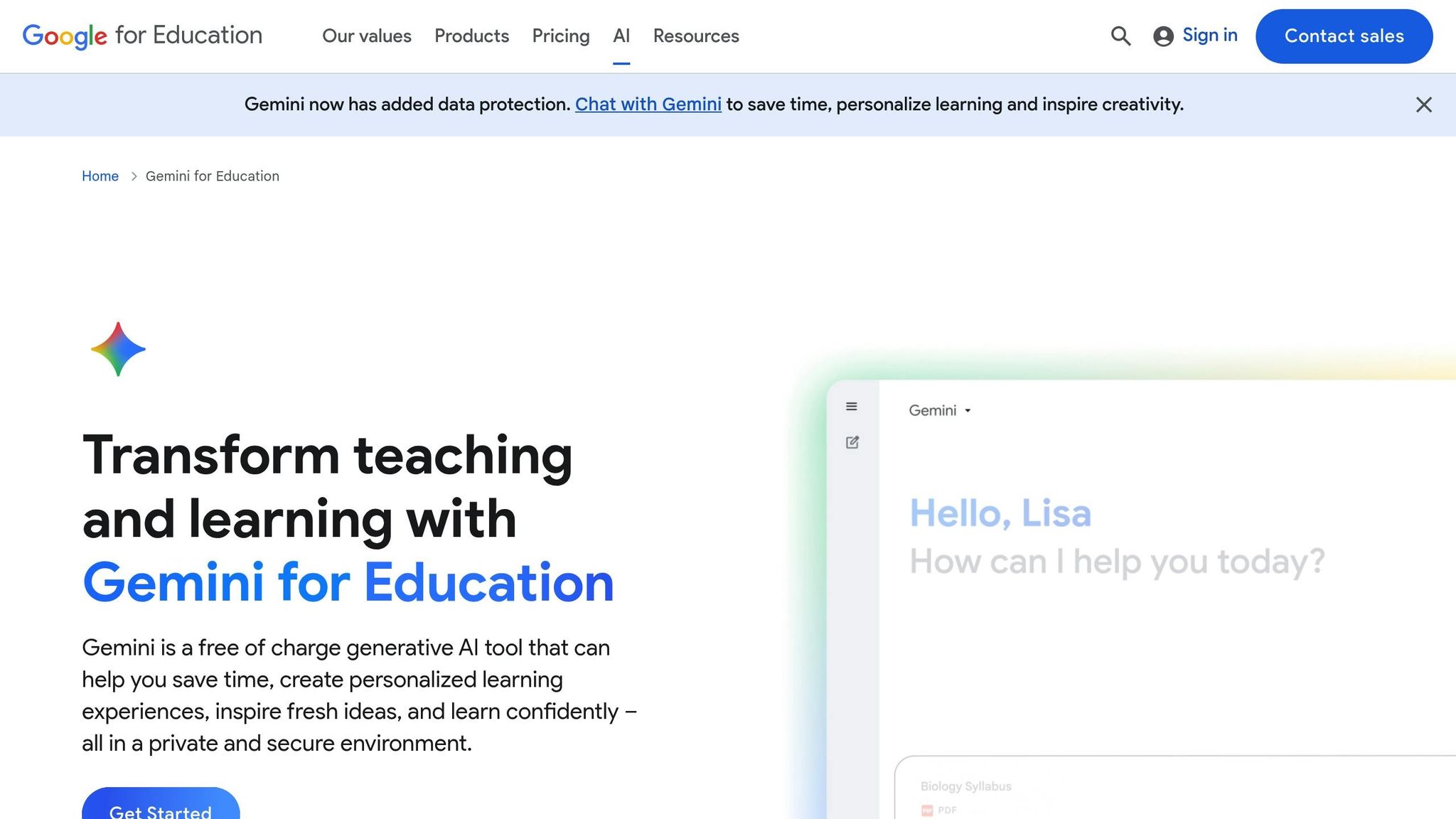
Google Gemini for Education is an AI-driven assistant tailored to help students with academic tasks. It’s designed to aid in research, writing, and solving problems, making it a valuable tool for students navigating their studies.
Features Designed for Students
While detailed specifications are still forthcoming, the tool emphasizes simplifying complex topics and organizing academic content. Its user-friendly approach aims to make managing schoolwork easier and more efficient.
How It Helps with Academic Tasks
Students can rely on Google Gemini for Education to break down tough concepts, draft essays, and condense course materials into manageable summaries. By streamlining these tasks, it helps boost productivity and supports better academic outcomes.
Availability and Privacy Safeguards
This tool is offered through educational institutions and adheres to strict privacy and data security protocols. Its institutional framework ensures students can access a secure and focused learning assistant.
More information on its specific features and usage guidelines will be shared as updates become available.
3. NotebookLM
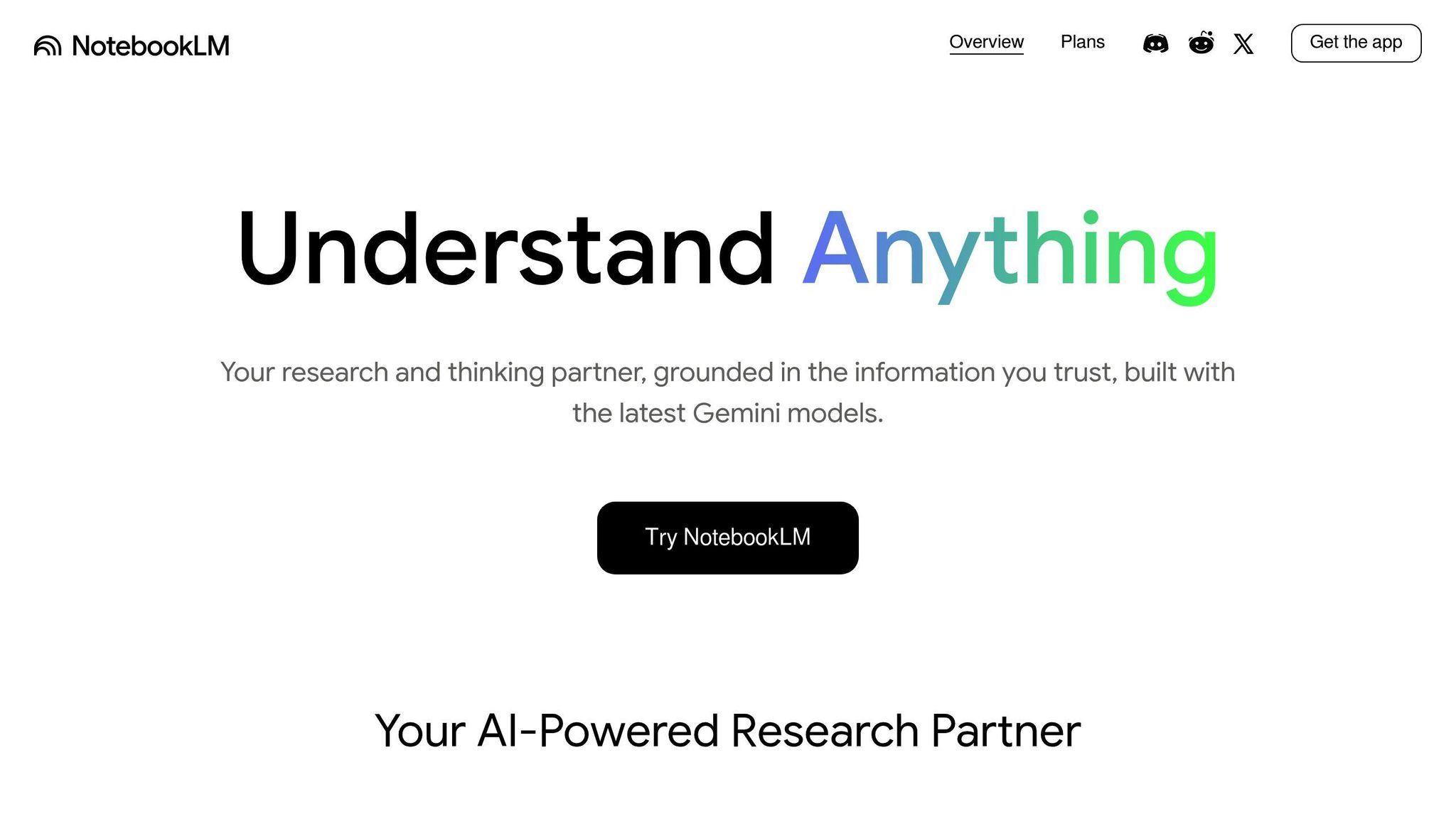
NotebookLM is a free AI tool designed to enhance academic productivity by offering personalized assistance. It uses Gemini's advanced multimodal capabilities to process a variety of formats, including PDFs, websites, YouTube videos, and audio files. These capabilities make it a versatile option for students looking to interact with academic content more effectively.
Key Features for Students
One standout feature of NotebookLM is its ability to extract insights from uploaded materials in multiple formats, such as text, video, and audio. It also includes an Audio Overviews feature, which creates engaging "Deep Dive" discussions, functioning like a personalized podcast experience. Additionally, the platform simplifies complex topics by summarizing uploaded content, making it easier for students to grasp challenging subjects quickly.
How It Helps with Academic Tasks
NotebookLM proves especially useful for a range of academic activities. For example, students can upload class notes, research materials, or other resources to efficiently organize and digest information. This makes tasks like writing papers, preparing for exams, and structuring study sessions much more manageable.
Free Plan and Usage Details
Currently, NotebookLM is free during its testing phase. The free plan allows users to create up to 100 notebooks, each capable of holding 50 sources. While there are daily limits on queries and audio summaries, these limits are generally sufficient for most students. Those with .edu email addresses can access premium features without any additional cost. For users needing more, the premium plan - priced at $19.99 per month - expands access to 500 notebooks, each supporting up to 300 sources, along with higher usage limits.
4. Quillbot
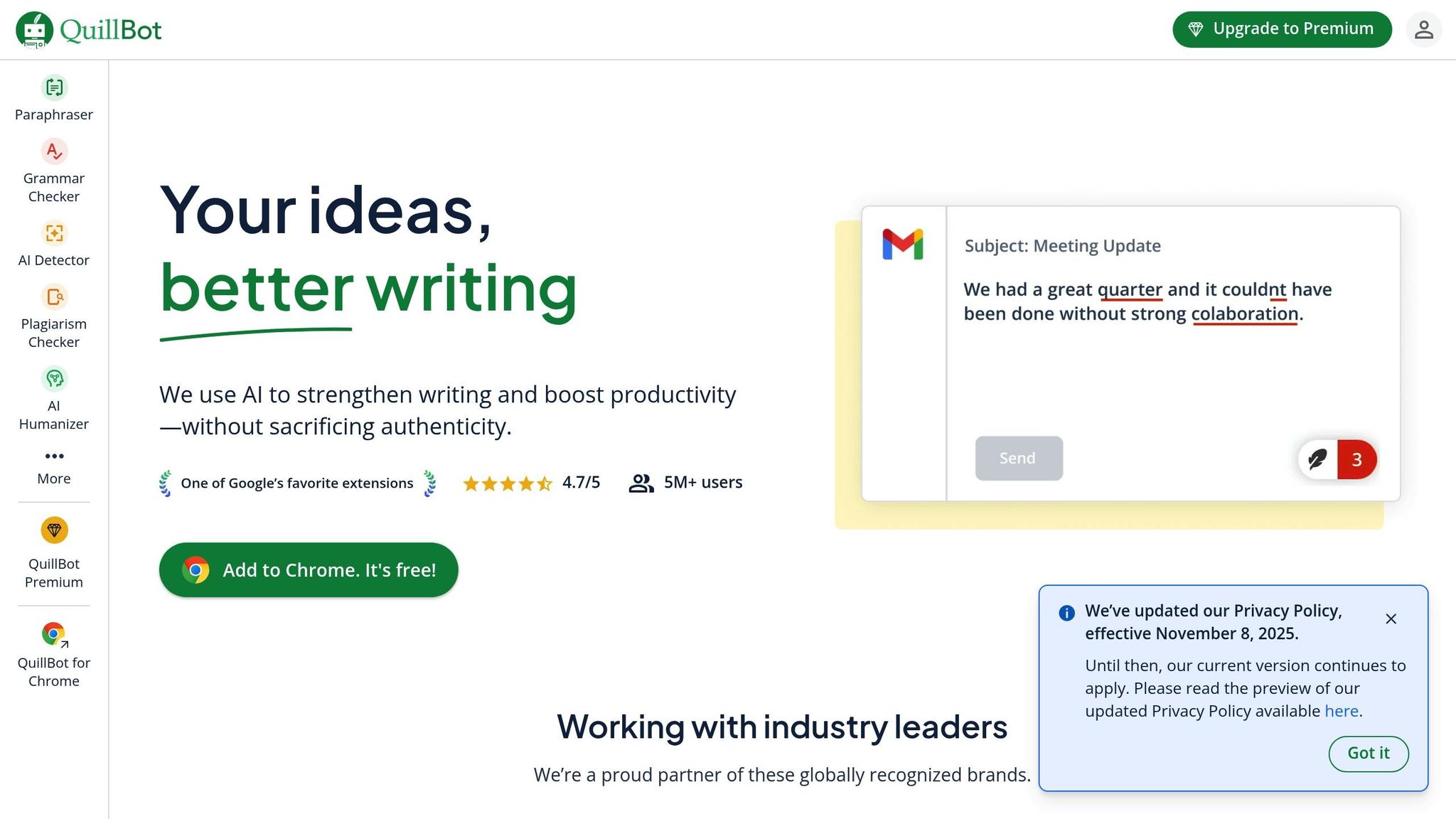
Quillbot is an AI-powered paraphrasing tool designed to transform student writing into polished, professional text. Beyond paraphrasing, it provides a range of writing tools tailored to meet various academic needs.
Key Features for Students
Quillbot's paraphrasing engine supports 23 languages and offers two modes: Standard and Fluency. One of its standout features is a color-coded system that highlights changes, making it easy to compare the original and revised text. But Quillbot doesn't stop there - it also includes a Grammar Checker, a CoWriter assistant, a Summarizer to condense long texts, and a Citation Generator for creating properly formatted academic references.
How Students Can Use Quillbot
Quillbot is a valuable tool for producing clear, concise academic writing. With its paraphrasing modes, students can refine essays or research papers to meet specific needs, whether focusing on maintaining the original tone or improving fluency. The color-coded highlighting feature doubles as a learning tool, showing exactly how the text has been improved. The Summarizer is perfect for extracting key points from lengthy research, while the Citation Generator simplifies the often tedious task of formatting references.
Free Plan and Usage
Quillbot operates on a freemium model, offering essential features at no cost. The free plan allows users to paraphrase up to 125 words at a time. For longer texts, students can break them into smaller chunks and still benefit from tools like the Grammar Checker, CoWriter, Summarizer, and Citation Generator. This makes Quillbot a robust, budget-friendly resource for any student's writing process.
5. Goblin Tools
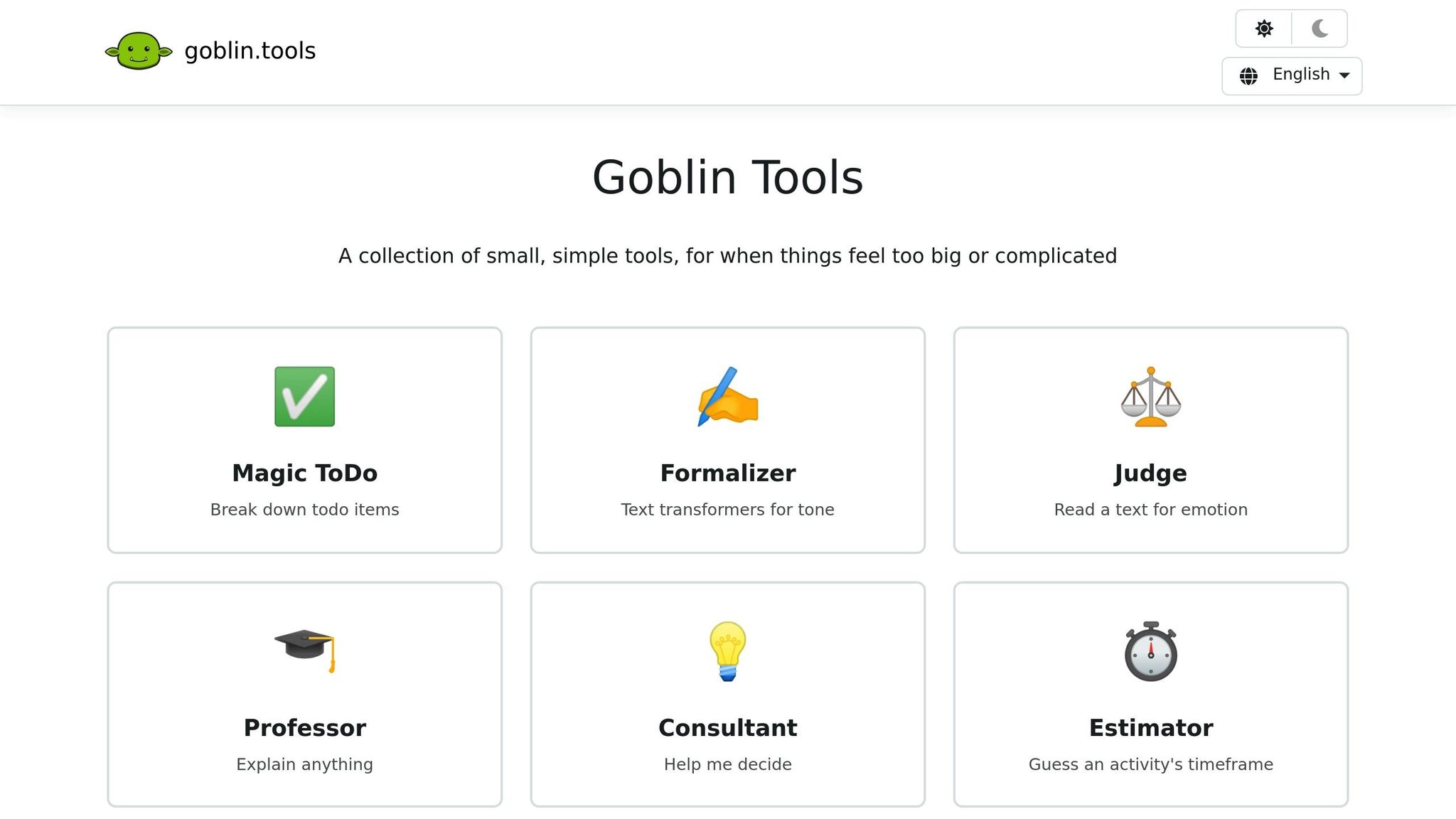
Next up in our review of free AI tools is Goblin Tools. While it’s featured in our directory and may have features that could help with academic tasks, specific details about its capabilities in this area remain unclear.
For the most accurate and up-to-date information on how Goblin Tools might assist with your academic needs, check out their official website.
6. Mindgrasp

Mindgrasp is listed in our AI tools directory, but detailed information about its specific features for students is currently unavailable. For the latest updates on how Mindgrasp can assist with academic tasks, it’s best to visit their official website.
Key Features Relevant to Students
At this time, there isn’t much clarity on what Mindgrasp offers in terms of academic support. Without documented details, it’s hard to provide concrete examples of how students might use it in their studies.
Free Plan Details and Usage Limits
Information about Mindgrasp’s free plan, including what’s included and any usage limitations, isn’t available based on our current research. Students should refer directly to Mindgrasp’s website to explore their pricing and any free options.
For the most accurate and updated information, visit Mindgrasp’s official site.
sbb-itb-212c9ea
7. MagicSchool.ai
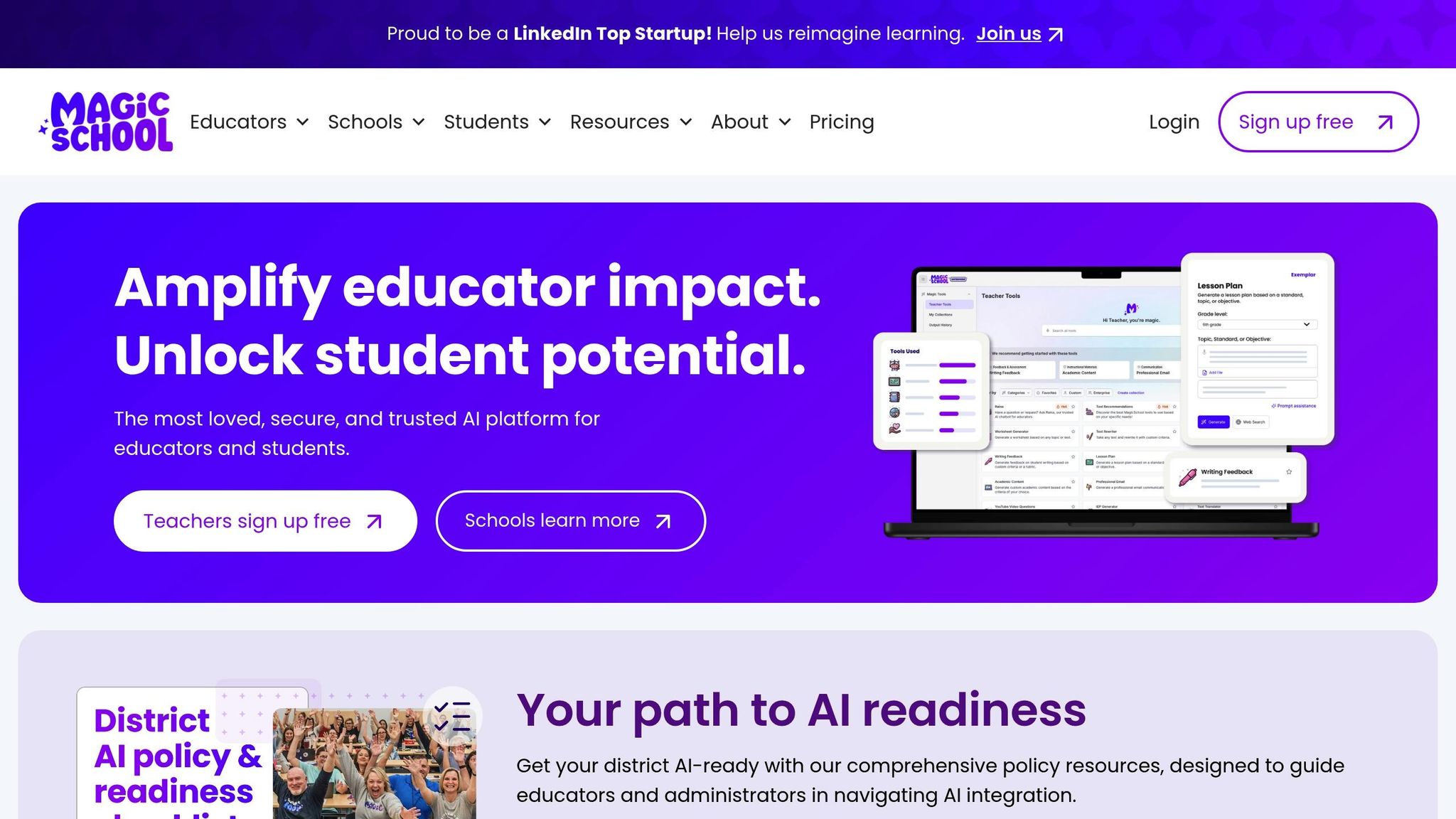
MagicSchool.ai is designed to introduce students to the world of AI through personalized learning experiences. The platform stands out with features that address potential biases in AI-generated content, ensure factual accuracy, and safeguard personal information. Its flexible design adapts to the unique needs of each student, all while prioritizing privacy - a key focus we'll explore further below.
Privacy and Accessibility Considerations
MagicSchool.ai takes privacy seriously. With over 6 million educators placing their trust in the platform, it has earned a 93% privacy rating from Common Sense Privacy and holds the ESSA Badge IV for meeting evidence-based standards. Additionally, the platform offers tailored data privacy agreements for school districts, ensuring a secure and compliant environment for educational use.
Free Plan Details
Students can access a variety of powerful learning tools on MagicSchool.ai, all at no cost.
8. Gibbly
Next up in our look at specialized academic tools is Gibbly, an AI-powered resource in the "Quiz/Assessment Generators" category. This tool is designed to create quizzes and assessments, making it easier for students to develop study materials tailored to their needs. To explore its features and learn about free usage options, check out Gibbly's official website.
9. Otter AI
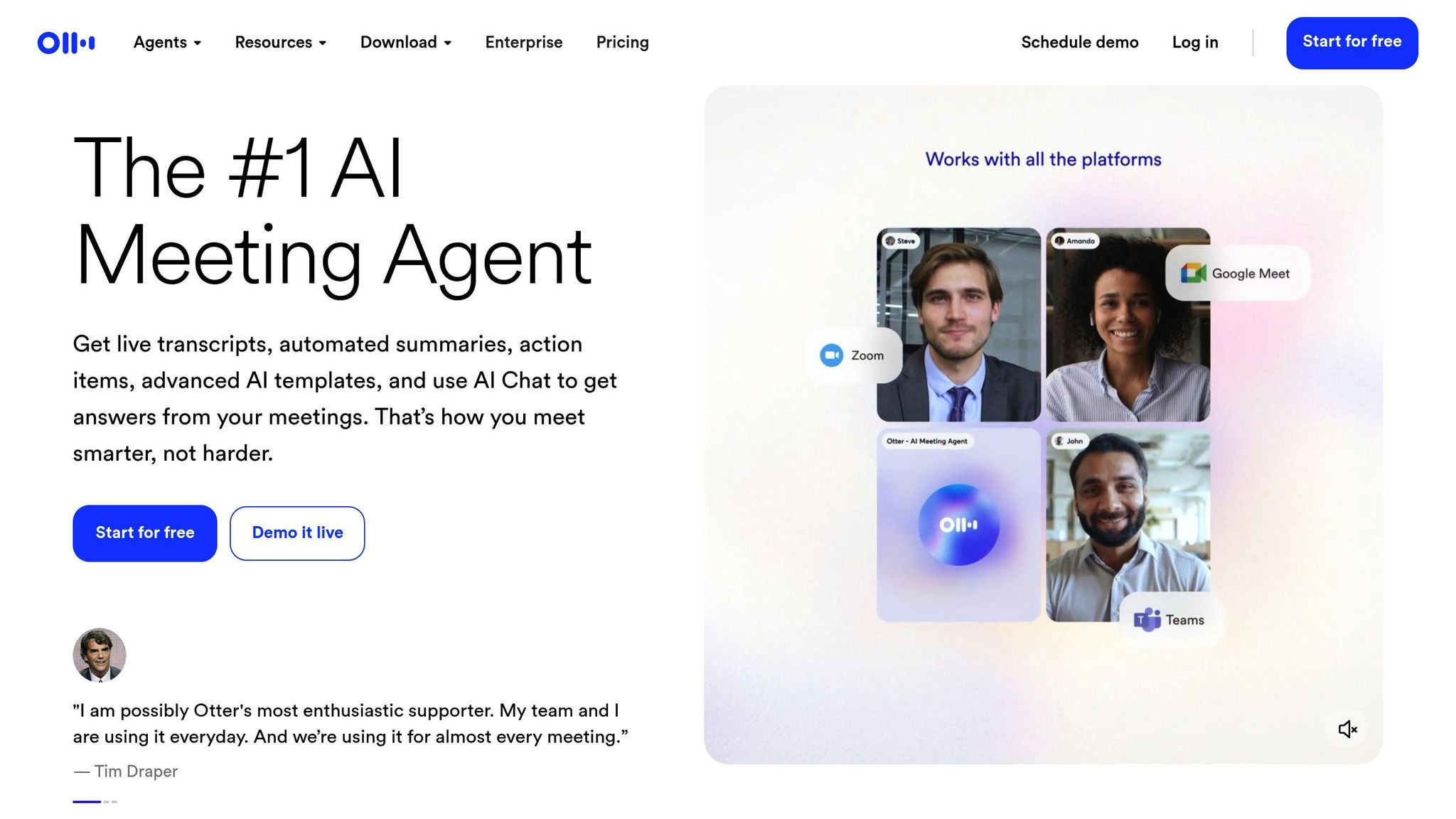
Otter AI is a transcription tool designed to make life easier by transcribing lectures and meetings in real time. It takes the hassle out of manual note-taking, so you can focus on what really matters - listening and engaging.
Features That Students Will Appreciate
Otter AI goes beyond simple transcription. It creates meeting summaries, notes, action items, and highlights key points from recorded discussions. Need something specific? You can interact with the tool through a chat feature to ask questions or even draft follow-up emails. It also integrates seamlessly with Zoom, Microsoft Teams, and Google Meet, automatically joining video calls to transcribe everything for you.
How It Helps With Academic Work
This tool removes the struggle of trying to listen while jotting down notes. With its automated summaries, you can quickly pinpoint the most important information, making it easier to review for exams or tackle assignments. It’s a great way to stay organized and save time.
Free Plan: What You Get
The free plan includes 300 transcription minutes per month, with a 30-minute cap per session. To make the most of it, focus on transcribing key parts of lectures or split longer sessions into smaller segments.
10. ChatPDF
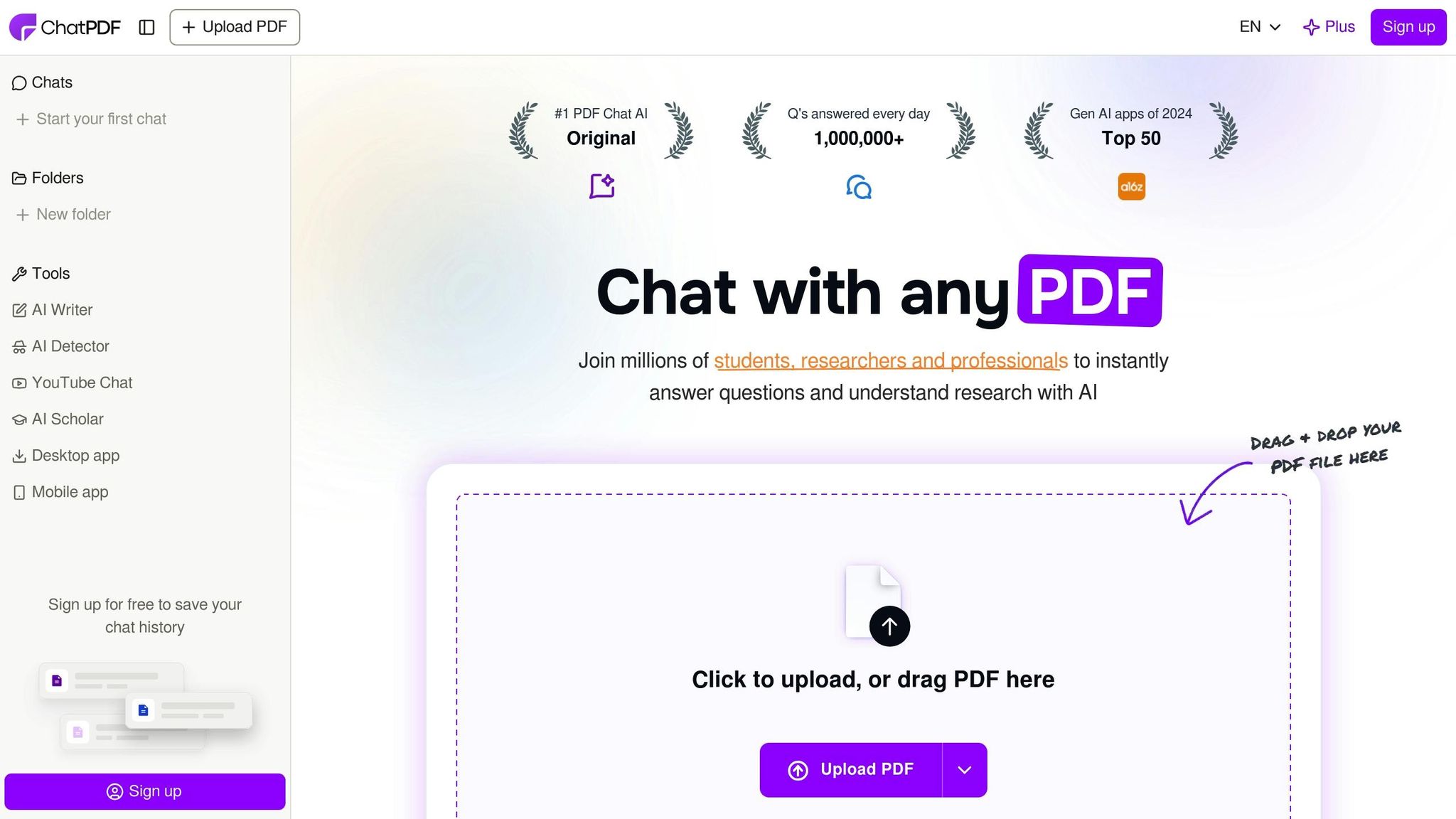
ChatPDF changes the way students interact with academic materials by turning static PDFs into dynamic, interactive chats. Instead of endlessly scrolling through pages to find specific details, you can simply ask questions and get answers directly from the document's content. It's a smart addition to the growing list of AI tools designed to streamline academic tasks.
This tool allows you to upload any PDF - whether it's a textbook, research paper, or academic journal - and transforms it into a chat-friendly format. The AI scans the entire document and provides answers tailored to your questions, using only the information contained in the uploaded file.
ChatPDF is especially useful for tackling dense academic content. Whether you're trying to decode complex research methodologies or grasp intricate theories, it simplifies the material into easy-to-understand responses based on your queries.
Practical Applications for Academic Tasks
ChatPDF proves invaluable for several academic activities. For research paper analysis, it eliminates the need to read entire journals to find relevant details. You can ask specific questions about methodologies, conclusions, or findings, saving time and effort when working on literature reviews or research projects.
When it comes to exam preparation, the tool helps you quickly clarify doubts and focus on key concepts from your study materials. You can request summaries of chapters, explanations of tough topics, or even practice multiple-choice questions based on your uploaded documents.
Assignments also become more manageable. Instead of combing through pages of text, you can upload the necessary materials and ask precise questions to extract the information you need for your homework or projects.
Free Plan Details and Usage Limits
ChatPDF offers a free plan that allows you to upload 2 PDFs per day and ask up to 20 questions daily. Each uploaded document can be up to 120 pages long.
To make the most of these limits, prioritize your most important documents for upload. Be as specific as possible with your questions to get the best results within the 20-question cap. If you're working with longer documents, consider splitting them into smaller sections or focusing on key chapters that fall within the page limit.
Privacy and Accessibility Considerations
Since you'll be uploading academic documents, which may include sensitive or personal information, it's important to note that ChatPDF processes these files through its AI system. Avoid uploading proprietary or confidential materials to stay on the safe side.
The tool operates entirely online, so you can access it from any device with an internet connection. Whether you're at home, in the library, or on campus, ChatPDF's flexibility ensures you can analyze your documents wherever you are.
Tool Comparison Chart
Explore the best AI tools for your academic needs with this side-by-side comparison. After reviewing individual tools, use this chart for a quick reference to match each tool to your tasks.
| Tool | Best Use Cases | Free Plan Limits | Key Features | Main Limitations |
|---|---|---|---|---|
| Google Gemini | Research, content creation, coding help | Basic AI tools included | Web summarization, image analysis, custom quizzes, and in-depth research with citations | Advanced features require Pro ($19.99/month) or Ultra ($124.99/month) subscriptions |
| NotebookLM | Organizing research and synthesizing content | Up to 100 notebooks and 50 sources per notebook | Summarizes PDFs, videos, and audio; creates Audio Overview podcasts | Still in testing phase |
| Quillbot | Improving writing and paraphrasing | Basic tools available | Grammar checks, citation generation, and content summaries | Premium features need a subscription |
| Otter AI | Transcribing lectures and meeting notes | Free plan with usage restrictions | Real-time transcription, summary generation, and AI-assisted search | Limited usage on free plan |
| ChatPDF | Analyzing documents and interacting with PDFs | Free plan with usage restrictions | Interactive Q&A for PDFs and academic material analysis | Limited usage on free plan |
This chart can help you create a productive study workflow. For example, you can organize your research with NotebookLM, refine essays with Quillbot, and dive into document details using ChatPDF. By combining these tools, you can make the most of their free features while streamlining your academic tasks.
Final Thoughts
The world of free AI tools for students is brimming with opportunities. The ten tools discussed here offer a practical way to reshape how you tackle academic tasks - whether it's researching, taking notes, writing, or collaborating with peers.
To make the most of these tools, start by pinpointing the areas where you face the most challenges. For instance, if organizing research feels overwhelming, NotebookLM can help you pull together insights from multiple sources. Struggling with writing? Quillbot can refine your drafts with its paraphrasing capabilities. The real strength of these tools lies in their ability to handle repetitive tasks, freeing up your time for deeper analysis and creative problem-solving. They’re designed to simplify your study routine.
Consider combining tools for even better results. Use Otter AI to transcribe lectures, NotebookLM to organize your findings, Quillbot to polish your writing, and ChatPDF to break down and analyze documents. This kind of integrated approach can supercharge your productivity without sacrificing the quality of your work.
That said, it’s important to approach AI tools with a clear understanding of their limitations. They’re not perfect and need human oversight. Always verify the information they provide and apply your own critical thinking to ensure accuracy. Additionally, check your school’s policies on AI use to avoid any issues before diving in.
As AI becomes more ingrained in education, new tools are continuously emerging. By starting with these free options and learning how to use them effectively, you’re not just improving your academic performance - you’re also building valuable digital skills that will benefit you in your career. Balancing AI’s capabilities with your own critical analysis can give you a strong edge in both academics and the workplace.
Take the time to explore and experiment with these tools to discover the combination that suits your learning style best. Mastering them now can make your academic journey more efficient and rewarding.
FAQs
What steps can students take to protect their privacy and keep their data secure when using free AI tools like Google Gemini and NotebookLM?
To keep your privacy intact and your data secure while using free AI tools, start by checking out the platform's privacy policy. This will give you a clear picture of how your data is collected, stored, and used. Always stick to tools from reliable providers that emphasize user security and are open about their data practices.
It's also smart to avoid sharing any sensitive personal information when using these tools. Make sure your accounts are protected with strong, unique passwords, and if the option is available, turn on two-factor authentication (2FA) for an extra layer of security. By following these steps, you can enjoy the benefits of AI tools without compromising your data.
How can students effectively combine AI tools to improve learning and productivity?
Integrating AI tools into your study routine can help you work smarter and get more done. The key is to combine tools that complement each other. For instance, an AI writing assistant can help you draft essays or brainstorm ideas, while a grammar checker ensures your work is polished and error-free. To stay organized, a task management app can help you plan schedules and track your progress. Meanwhile, transcription tools are great for capturing and reviewing lecture notes without missing any details. By using these tools together, you can simplify your study process and dedicate more time to meaningful learning.
What are the potential downsides of using AI tools for schoolwork, and how can students overcome them?
AI tools can be a great aid for academic tasks, but they’re not without their flaws. One of the main concerns is that the content they produce isn’t always accurate or reliable. That’s why it’s crucial for students to cross-check any information they get from AI against credible sources to ensure its validity.
Another challenge is the temptation to rely too heavily on these tools, which can hinder the development of essential skills like critical thinking and problem-solving. To make the most of AI without losing these abilities, students should treat these tools as helpers, not substitutes. Staying actively involved in their own learning and balancing AI assistance with independent study and analysis is the best way to reap the benefits while minimizing the risks.
